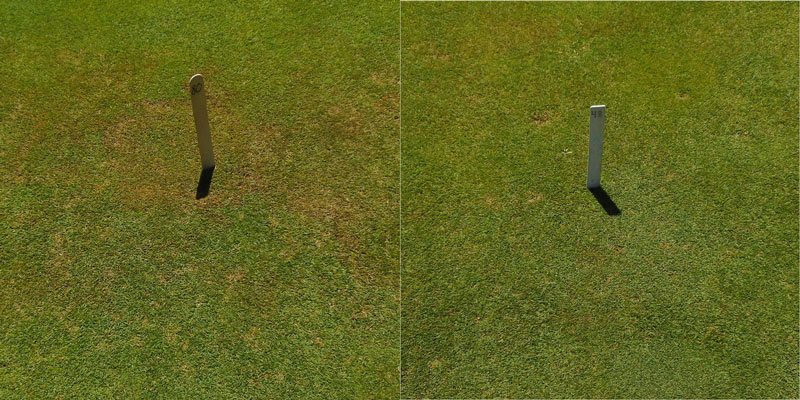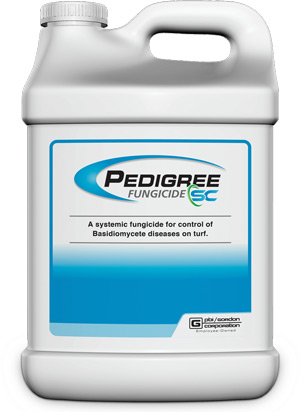
A 2018 Rutgers University study showed Pedigree
Fungicide SC is effective in controlling brown patch. Photos courtesy of PBI-Gordon
Editor’s note: The following article was supplied by PBI-Gordon. All product claims, research cited and other information is directly from the company.
In professional turfgrass management, water is a good thing. But you know what they say about “too much of a good thing.” Too much moisture, be it rain, irrigation, or humidity, tends to bring disease, and that’s never a good thing.
One of the most common turfgrass diseases — and one of the most damaging — is brown patch (Rhizoctonia solani). But with proper diagnosis, prevention and control, you can stop it from hurting your turf.
Brown patch is a cool-season turfgrass disease that is most active during summer. Especially problematic on tall fescue lawns, its symptoms can vary greatly with the type of grass and soil conditions. Those symptoms include circular or irregular brown
patches in the turf stand, ranging in diameter from a few inches to several feet. Some patches may have a dark “smoke ring” around the edge, which is indicative that the pathogen is active and infecting new plants.
Brown patch is a foliar disease, so it impacts the grass leaves rather than the crown or roots. The turf damage is generally more aesthetic than permanent unless the disease is left uncontrolled for an extended period of time. Left unchecked, however,
brown patch can kill turfgrass.
R. solani, the pathogen that causes brown patch, may be present in the soil for years before it manifests as the disease when the conditions are right. Brown patch thrives in high humidity and warm temperatures. It requires approximately 10 hours
of relative humidity in excess of 90%, plus daytime temperatures of 80 degrees F or greater, and nighttime temperatures in excess of 65 degrees F.
There’s a common notion that brown patch severity is increased by quick-release nitrogen fertilizers. This long-held belief isn’t entirely true, however. According to research by North Carolina State University, brown patch severity did not significantly increase with moderate fertility applications in the spring and summer months.
This solidifies the idea that maintaining adequate fertility is important in preventing and controlling brown patch, along with cultural management strategies that increase air movement and reduce leaf moisture.

Complementing cultural management for control of brown patch, a wide variety of fungicides have proven effective. Pedigree Fungicide SC from PBI-Gordon features an active ingredient familiar to the industry: flutolanil. A SDHI fungicide (FRAC 7) used for disease control in turf, flutolanil has no documented cases of
resistance, making it ideal for a rotation program.
What makes Pedigree different from other flutolanil products is that Pedigree is a liquid, suspension concentrate formulation. It offers the same proven performance as granular flutolanil in a liquid formulation, making it easier to handle and apply compared
with watered-dispersible granule (WG) formulations.
Following label instructions, Pedigree is applied to the soil or base of the plant, where it translocates upward in the plant to deliver proven disease control. In addition to brown patch control, Pedigree controls brown ring patch, fairy ring, red thread,
pink patch, yellow patch, gray snow mold, large patch, and leaf and sheath spot on turf.
The most effective thing we can do to control all turf diseases remains preventing them through best management practices. That includes proper irrigation, air circulation and fertilization — especially with nitrogen. And it’s vital to the
future success of our industry to develop and follow a resistance management program.